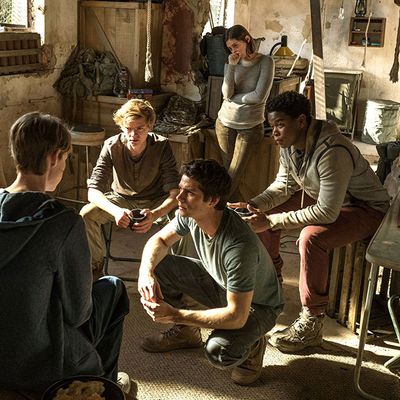
Maze Runner: The Death Cure was my first Maze Runner, and I think I did a pretty good job watching it, all things considered. Before the Mazehead community gets on me for this, I’ll submit, by way of excuse, that I have been haunted by a persistent eye-strain headache for the past week, and watching the first two Maze Runners did not seem quite like the death cure for me. Also, I mean, I got it. I put it all together rather quickly, and what’s more, I had a pretty great time. I don’t know if I could have said the same thing if I stepped into, say, The Return of the King completely blind.
Which speaks more to the skill of director Wes Ball and his engaging cast, all of whom are able to wordlessly communicate dynamics and histories that I’m grateful the script did not spend too much time rehashing. I could tell that Brenda (Rosa Salazar) had a crush on Thomas (Dylan O’Brien) but was obviously doomed to Eponine status. I knew Kaya Scodelario was in these movies, and she was absent, and I was pretty sure that there was a boy who missed her, and it was probably our dewy-eyed Thomas. And the rest of the boys have the feeling of soldiers-in-arms who bonded over many a maze run together. (Just one, it turns out, but I suppose it only takes one.) The Maze Runner films are the more boy-driven, combat-oriented rejoinder to the fading post-apocalyptic YA boom, which consequently makes them lighter on their feet as action films.
The Death Cure picks up after the betrayal of Scodelario’s Teresa, who has joined the big bad WCKD organization (pronounced “Wicked,” somehow the jury’s still out at the start of the film whether they’re completely evil or not) to try to find a cure for the “Flare” disease that’s been wiping out the human population and turning them into zombies. While the rest of the gang pulls off daring rescues of captive would-be Maze Runners, Teresa wears a lab coat and works on science stuff with Patricia Clarkson. Their current test subject is Thomas’s buddy Minho (Ki Hong Lee), and the gang decides to set off on a rescue mission to retrieve him from the gleaming, impenetrably walled Last City, where WKCD is headquartered.
The film draws its sci-fi tropes from everything from Blade Runner to The Road Warrior to 28 Days Later to Final Fantasy VII, but at teen-movie scale, where there’s a ceiling to the violence and the cursing (boy, do these kids like to say “shit,” though), and there’s something delightfully accessible about it all. The young cast give great face, particularly Salazar and Lee, and there’s always some emotional teen to root for in the midst of Ball’s numerous, seemingly never-ending action set pieces. This is the sort of action film where the bad guys often hold their fire for no discernible reason, and are terrible at dodging things, but if one suspends one’s disbelief long enough, they’re rewarded with a rollicking, highly competent popcorn movie.
The problem is that at two hours and there’s an awful lot of this popcorn movie, and it suffers from the same too-many-climaxes ailment that affects movies much bigger and more expensive than this. Honestly, when was the last time the climax was your favorite part of a movie, outside of the Fast and Furious franchise? I rather enjoyed the moral murk when it seems like selective teen torture could provide a cure for the zombie apocalypse, I liked our characters’ (and our) uncertainty about which way Theresa would swing, I particularly liked a ludicrous, video-game-worthy rescue involving a bus and a crane (I figured it was part of the climax but turned out to be nearly an hour out from it). But when it comes time to devote multiple scenes and shoot-outs to Aidan Gillen’s WCKD big bad Janson, nearly a nonentity at this point in the story, it feels like it’s stalling, down to the very last death-defying leap. But for what? Everything else in The Death Cure moves along assuredly and relentlessly, but like so many final installments of series, it has a hard time letting go.

